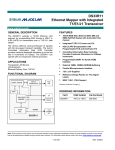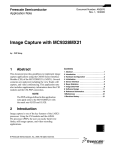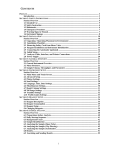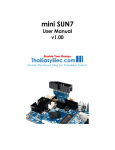Download Using the MC9328MX21 (i.MX21)
Transcript
Freescale Semiconductor Application Note AN2868 Rev. 1, 11/2004 Using the MC9328MX21 (i.MX21) to Create a VGA Digital Photo Album by: Amanda McGregor 1 Abstract This application note gives an overview of the MC9328MX21 (i.MX21) processor’s Liquid Crystal Display Controller (LCDC) functionality, and discusses how the new graphics window feature can be used for creating a VGA Digital Photo Album application with a 10.4” NEC VGA display. 2 Introduction The i.MX21 processor’s LCDC is an enhanced version of the LCDC found on the previous versions of the i.MX family (i.MX1 and i.MXL). The i.MX21 processor’s LCDC adds the following features: • Supports displays up to 800 × 600. • Supports color up to 18bpp—that is, 262K different colors. • Supports the management of a second display area, called the “graphics window”, and blends the graphics window with the main display area. © Freescale Semiconductor, Inc., 2004. All rights reserved. Contents 1 2 3 4 5 6 7 8 Abstract . . . . . . . . . . . . . . . . . . . . . . . . 1 Introduction . . . . . . . . . . . . . . . . . . . . . 1 i.MX21 LCDC Functional Overview . . 2 Use Case: VGA TFT LCD . . . . . . . . . . 10 VGA Digital Photo Album . . . . . . . . . 13 Conclusion . . . . . . . . . . . . . . . . . . . . . 25 Reference Documentation . . . . . . . . . 26 Revision History . . . . . . . . . Back Cover i.MX21 LCDC Functional Overview Many applications require the use of a VGA resolution display. On previous generations of i.MX it has been difficult to support the bandwidth required by a VGA panel. Enhancements to the LCDC in the i.MX21 processor enable the i.MX21 to easily support displays up to VGA resolution at 18bpp color depth. This application note introduces the VGA Digital Photo Album application, specifically designed to test the VGA capabilities of the i.MX21 processor’s LCDC and to demonstrate the new graphics window feature. 3 i.MX21 LCDC Functional Overview This section gives an overview of the features of the i.MX21 processor’s LCDC, in particular the graphic window functionality, new to the i.MX21. Following this, a detailed functional description of the i.MX21 processor’s LCDC is given, including a description of the parameters important to its configuration. As described previously, this section will focus on the application of the i.MX21 processor’s LCDC to drive an active matrix (TFT) display. 3.1 i.MX21 Processor’s LCDC Sub-System Figure 1 shows the functional block diagram of the i.MX21 processor’s LCDC for an active matrix display with graphics window functionality enabled. B a c k g r o u n d P la n e DM A B y te Sw ap F IF O P a n n in g D a ta S h ifte r DM A B y te Sw ap F IF O P a n n in g D a ta S h ifte r LCDC A r b ite r G r a p h ic W in d o w In te r fa c e B u ffe r C o lo r C u rs o r In te r fa c e L o g ic D is p la y 4bpp 8bpp 4bpp 8bpp 256x18 BGLUT 18bpp 256x18 GW LUT 18bpp 12bpp 16bpp 18bpp A lp h a B le n d in g Figure 1. Block Diagram of Display Sub-System (8bpp Active Matrix) As shown in Figure 1 there are two parallel data paths—one for the background plane and one for the graphic window, called the foreground plane. Data for the background and foreground planes are fetched from system memory (for example, SDRAM) via the LCDC’s internal DMA controller. The LCDC DMA controller accesses the system memory using fixed length or dynamic burst length, depending on the desired system performance. For a more heavily loaded system, the dynamic burst length option should be selected to minimize system bus loading. Section 3.2.2, “LCD Size, Image Location in Memory, and Bus Loading on page 4 discusses the bus loading effect for different panel sizes and burst options. Note that the DMA settings for the background and foreground plane can be configured separately, however it is common practice to set them to the same value. Data for the foreground and background plane is fetched and loaded into the foreground and background buffers, respectively. The buffers are each 32 × 32-word pixel buffers. Each buffer has a corresponding Using the MC9328MX21 (i.MX21) to Create a VGA Digital Photo Album, Application Note, Rev. 1 2 Freescale Semiconductor i.MX21 LCDC Functional Overview high and low watermark value associated with it. When in dynamic burst mode, data is loaded into the buffer until the number of empty words in the buffer equals the high watermark minus 2. When in fixed burst mode, the burst length (in words) is equal to the high watermark. When the number of words left in the buffer equals the low watermark, a DMA request is triggered. After data is loaded into the buffer, the LCDC performs byte swapping on the data if an endianness change is required, followed by panning operations, if panning is selected. If the data is 4bpp or 8bpp format, then the 4bpp or 8bpp data is used as an index into a 256 × 18-bit look-up table to generate an 18-bit color. Data of 12bpp, 16bpp, and 18bpp does not use the look-up table. The background data and graphics window data then goes to the alpha blending module, which mixes the background and graphics window according to the alpha value or color key, whichever mode is selected, and generates a single image to be displayed. After the alpha blending module, the color cursor is overlaid with the data to be displayed. The data then goes into a buffer, goes through the interface logic, and is sent to the display. 3.2 i.MX21 Processor’s LCDC Configuration There are many different parameters that need to be set to enable proper functioning of the LCDC with the target display. This section outlines the parameters that need to be configured, the corresponding registers that the parameters are stored in, and in some cases, example code of how to set these parameters. This section also discusses the timing considerations for an LCD, which depends on the resolution of the display. 3.2.1 LCDC Clock Configuration Configuring the LCDC clock is one of the most critical tasks in establishing a correctly functioning LCDC and display. Figure 2 shows the clock sources to the LCDC, as well as the output clock that is sent to the display. Note that the diagram depicts an 18bpp active matrix (TFT) display. Shift Register 32x32 Pixel Buffer Memory + ARM926EJ-S Data Input LD[0…17] DMA Data Input SysPLL BCLKDIV To 18bpp TFT display HCLK Divide by 1...16 SysPLL PERDIV3 Divide by 1...64 PERCLK3 PCD Divide by 1…64 LCDC LSCLK Figure 2. LCDC Input and Output Clocks Using the MC9328MX21 (i.MX21) to Create a VGA Digital Photo Album, Application Note, Rev. 1 Freescale Semiconductor 3 i.MX21 LCDC Functional Overview Figure 2 illustrates the two clock sources of the LCDC. The description of the clocks follow: • HCLK—Generated from the System PLL frequency and the value of BCLKDIV (bits [13:10]) in the Clock Source Control Register (CSCR). Typically the System PLL is set to 266 MHz. At reset, BCLKDIV has a value of 1, meaning that HCLK is BCLK divided by 2—that is, 133 MHz. • PERCLK3—Generated from the System PLL frequency and the value of PERDIV3 (bits [21:16]) in the Peripheral Clock Divider Register 1 (PCDR1). PERCLK3 is exclusively used by the LCDC. At reset, PERDIV3 has a value of 7, meaning that PERCLK3 is BCLK divided by 8—that is, 33.25 MHz. The LCDC generates a clock for internal use by the data shift register to control the rate at which data is sent to the display, PIXCLK, and an interface clock that is sent externally to the display, LSCLK, for latching the pixel data. • PIXCLK—Generated from PERCLK3 and the value of PCD (bits [5:0]) in the LCDC Panel Configuration Register (LPCR). It is used for latching the pixel data into the shift register internal to the LCDC, in preparation for sending out to the display. For a color TFT display, PIXCLK is the same as LSCLK1. At reset, PCD has a value of 0, meaning that PIXCLK is PERCLK divided by 1—that is, 33.25 MHz. • LSCLK—Generated from PERCLK3 and the value of PCD (bits [5:0]) in the LCDC Panel Configuration Register (LPCR). It is sent externally to the display for latching of the pixel data into the display’s shift registers. Like the PIXCLK, LSCLK is 33.25 MHz out of reset. The LSCLK value must be at least one third of the HCLK frequency in TFT mode to ensure that data is output correctly from the LCDC. Otherwise, timing problems occur and the output from the LCDC is unpredictable. HCLK can be set to a maximum of 133 MHz, meaning that LSCLK can be no faster than 44.3 MHz. This should be sufficient to meet the timing specifications of displays up to VGA resolution. The frequency setting of LSCLK is determined by the display itself. The user will need to ensure that LSCLK is set within the approved values as described in the display specification. Assuming the bus bandwidth is sufficient to support the display resolution and frame rate, keeping the LSCLK within the range specified in the panel specification should result in a flicker-free display. Visual verification of the LSCLK frequency by probing LSCLK with an oscilloscope is recommended if problems are encountered. Further information on the i.MX21 processor’s clocking scheme can be found in the i.MX21 Reference Manual. 3.2.2 LCD Size, Image Location in Memory, and Bus Loading The LCDC uses five parameters to determine the resolution of the panel, the starting memory address of the image to be displayed, and how to get each successive line of data for display. The storage area in memory is typically referred to as a “frame buffer”. The parameters are depicted in Figure 3. 1. For a monochrome display, PIXCLK is faster than LSCLK by a factor equal to the number of pixels in an output vector. Using the MC9328MX21 (i.MX21) to Create a VGA Digital Photo Album, Application Note, Rev. 1 4 Freescale Semiconductor i.MX21 LCDC Functional Overview Virtual Page Width (VPW) SSA Virtual Page Height (VPH) Screen Width (XMAX) Screen Height (YMAX) Figure 3. LCD Screen Size Parameters As shown in Figure 3, the screen size parameters are as follows: • Screen Width (XMAX)—Indicates the width of the display, in terms of pixels divided by 16. XMAX = Width of display (in pixels) / 16 • Screen Height (YMAX)—Indicates the height of the display, in terms of the number of lines. YMAX = Height of display (in pixels) • • • Screen Starting Address (SSA)—Starting address in memory of the active area of the frame buffer—that is, the address of the first pixel to be displayed on the LCD, pixel (0,0). The screen starting address can be modified, for example if you want to pan over another part of the frame buffer. Virtual Page Width (VPW)—Width of the frame buffer, in terms of the number of 32-bit words required to hold the data for one “virtual” line. VPW is used to calculate the starting address of the next line of data to be displayed on the LCD. Note that VPW may be larger than the width of the display to allow panning over different areas of the frame buffer, however must represent at least one full line of the resolution of the display to prevent artifacts on the LCD. Virtual Page Height (VPH)—Height of the frame buffer. This value is not a parameter in the LCDC register set, however is used in a software program for boundary checks when updating frame buffer content. Generally, the LCDC supports up to SVGA resolution—that is, 800 pixels wide by 600 pixels high. However, the bandwidth required by an SVGA resolution display at 18-bit color is significant and the user must ensure that enough system bandwidth is available such that an underrun error does not occur. An underrun error occurs when the DMA cannot keep enough data in the LCDC FIFO, and the result is that incorrect data is sent to the display. When the underrun error is corrected, the content on the display will not be fixed until the next VSYNC is sent to the display. We can calculate the theoretical bus load based on various LCD resolutions and color depths, assuming a constant 60fps refresh rate. Table 1 shows the theoretical bus load, based on a fixed LCDC DMA burst memory access of 8 words—that is, 8 × 32-bits. The calculations also assume that for each burst of 8 words, the total clock cycles required to read the data consists of 8 clocks of memory setup time plus 8 clocks to read back the 8 words of pixel data. This means that we are only receiving pixel data half of the time, so a correction factor needs to be applied to the memory bandwidth calculation. Using the MC9328MX21 (i.MX21) to Create a VGA Digital Photo Album, Application Note, Rev. 1 Freescale Semiconductor 5 i.MX21 LCDC Functional Overview Maximum memory bandwidth = memory bus speed × bus width × correction factor For example i.MX21, Max. Bus Bandwidth = 133MHz × 32-bits × 1/2 = 2128 Mbits/s Table 1. Bus Bandwidth Comparison for Different Resolutions and Color Depths Display Resolution Color Depth Theoretical Bus Bandwidth Theoretical i.MX21 Bus Load (LCDC DMA fixed @ 8 words per burst, HCLK = 133MHz) QVGA (320 x 240) 8bpp 320 x 240 x 8bpp x 60fps = 37 Mbits/s 37 Mbits/s / 2128 Mbits/s = 1.7% QVGA (320 x 240) 16bpp 320 x 240 x 16bpp x 60fps = 74 Mbits/s 74 Mbits/s / 2128 Mbits/s = 3.5% QVGA (320 x 240) 18bpp (unpacked) 320 x 240 x 32bpp x 60fps = 148 Mbits/s 148 Mbits/s / 2128 Mbits/s = 6.9% VGA (640 x 480) 8bpp 640 x 480 x 8bpp x 60fps = 148 Mbits/s VGA (640 x 480) 16bpp 640 x 480 x 16bpp x 60fps = 295 Mbits/s 295 Mbits/s / 2128 Mbits/s = 13.9% VGA (640 x 480) 18bpp (unpacked) 640 x 480 x 32bpp x 60fps = 590 Mbits/s 590 Mbits/s / 2128 Mbits/s = 27.7% SVGA (800 x 600) 8bpp 800 x 600 x 8bpp x 60fps = 230 Mbits/s 230 Mbits/s / 2128 Mbits/s = 10.8% SVGA (800 x 600) 16bpp 800 x 600 x 16bpp x 60fps = 461 Mbits/s 461 Mbits/s / 2128 Mbits/s = 21.7% SVGA (800 x 600) 18bpp (unpacked) 800 x 600 x 32bpp x 60fps = 922 Mbits/s 922 Mbits/s / 2128 Mbits/s = 43.3% 3.2.3 LCDC Active Matrix Interface Signals Table 2 on page 6 provides the external signals generated by the LCDC and used by the active matrix display. Note that passive matrix signals are not included in this table. Table 2. LCD Controller Signal Description Signal Name Description LD[17:0] LCD Data Bus—All LCD signals are driven low out of reset and when LCDC is off. VSYNC Indicates the start of the next frame of data (called SPS for Sharp 320 HSYNC Indicates the start of the next line of data. LSCLK Clock for latching data into the display driver’s internal shift register. Output from the LCDC, and must be less than 1/3 of the HCLK (for TFT panels). OE Output enable signal to enable data to be shifted onto the display. CONTRAST Used to control the LCD bias voltage to modify the contrast of the display. SPL_SPR Sets the horizontal scan direction (for Sharp 320 PS × 240 HR-TFT panel). × 240 HR-TFT panels only). Control signal output for source driver (for Sharp 320 × 240 HR-TFT panels only). CLS Start signal output for gate driver. This signal is an inverted version of PS (for Sharp 320 only). REV Signal for common electrode driving signal preparation (for Sharp 320 × 240 HR-TFT panels × 240 panels only). Using the MC9328MX21 (i.MX21) to Create a VGA Digital Photo Album, Application Note, Rev. 1 6 Freescale Semiconductor i.MX21 LCDC Functional Overview 3.2.4 Active Matrix Panel Timing 3.2.4.1 Horizontal Timing The horizontal timing parameters for an active matrix display are shown in Figure 4. These timing parameters collectively describe the timing required to display one line of data on the display. Note that in this timing diagram example, HSYNC, OE, and VSYNC are all active high signals. The clock polarity is set such that the display latches the data on the negative edge of the clock. Signal polarities are programmable in the LCDC Panel Configuration Register. H _W ID T H H _W A IT _ 2 X M AX H _W A IT _ 1 P IX C L K HSYNC OE DATA VSYNC Figure 4. Horizontal Timing for Active Matrix LCD Figure 4 shows that there are four parameters used to describe the HORIZONTAL timing of an active matrix panel. These parameters are: • H_WIDTH—Defines the width of the horizontal synchronization (HSYNC) pulse, which is used to indicate the end of the line. It must be at least 1 clock. Total active time is H_WIDTH + 1. H_WAIT_1 – is called the “front porch” and defines the delay from the negation of the output enable (OE) signal to the beginning of the next HSYNC pulse. Total delay is H_WAIT_1 + 1. • • • • H_WAIT_2—Called the “back porch” and defines the delay from the negation of the HSYNC signal to the assertion of OE. Total delay is H_WAIT_2 + 3. XMAX—Defines the total number of pixels in the line, for example XMAX would have a value of 640 for a landscape mode VGA panel. H_WAIT_1 + H_WIDTH + H_WAIT_2—Defines the delay (in pixel clocks) between the end of one line and the beginning of the next line—that is, the time required for the LCD panel to re-initialize to receive the next line of data. H_WAIT_1 + H_WIDTH + H_WAIT_2 + XMAX—Defines how long it takes (number of pixel clocks) to display an entire line of data. All of the parameters listed above are defined in the display data sheet. The data sheet will provide guidance on the range of values for H_WIDTH, H_WAIT_1, and H_WAIT_2. XMAX is determined by the number of pixels per row that is to be displayed; the maximum value of XMAX is the maximum width (in terms of number of pixels) of the display. Using the MC9328MX21 (i.MX21) to Create a VGA Digital Photo Album, Application Note, Rev. 1 Freescale Semiconductor 7 i.MX21 LCDC Functional Overview 3.2.4.2 Vertical Timing The vertical timing parameters for an active matrix display are shown in Figure 5. These timing parameters collectively describe the timing required to display one frame of data on the display. Note that in this timing diagram example, HSYNC, OE and VSYNC are all active high signals. Signal polarities are programmable in the LCDC Panel Configuration Register. End of frame Beginning of frame V_WIDTH (lines) YMAX VSYNC HSYNC OE V_WAIT_1 V_WAIT_2 Figure 5. Vertical Timing for Active Matrix LCD As shown in Figure 5, there are four parameters used to describe the VERTICAL timing of an active matrix panel. These parameters are: • V_WIDTH—Defines the width of the vertical synchronization (VSYNC) pulse, which is used to indicate the end of the frame. It must contain at least 1 HSYNC pulse—that is, one line period. • V_WAIT_1—Defines the number of line periods between the negation of OE—that is, all data for the last line of the frame has been sent, and the assertion of VSYNC. • V_WAIT_2—Defines the number of line periods between the negation of VSYNC and the assertion of OE—that is, data for the first line of the next frame begins to be sent. • YMAX—Defines the total number of lines in the frame, for example YMAX would have a value of 480 for a landscape mode VGA panel. • V_WAIT_1 + V_WIDTH + V_WAIT_2—Defines the delay (in line periods) between the end of one frame and the beginning of the next frame—that is, the time required for the LCD panel to re-initialize to receive the next frame of data. • V_WAIT_1 + V_WIDTH + V_WAIT_2 + YMAX—Defines how long it takes (number of line periods) to display an entire frame of data. All of the parameters listed above are defined in the display data sheet. The data sheet will provide guidance on the range of values for V_WIDTH, V_WAIT_1 and V_WAIT_2. YMAX is determined by the number of lines that is to be displayed; the maximum value of YMAX is the maximum height (in terms of number of lines) of the display. Using the MC9328MX21 (i.MX21) to Create a VGA Digital Photo Album, Application Note, Rev. 1 8 Freescale Semiconductor i.MX21 LCDC Functional Overview 3.2.5 New on the i.MX21: Graphics Window A new feature introduced in the i.MX21 processor’s LCDC is the graphics window. The graphics window feature was introduced in Section 3.1, “i.MX21 Processor’s LCDC Sub-System and Section 3.2, “i.MX21 Processor’s LCDC Configuration, however is described in more detail within this section, including how a graphics window is used and how it is configured for operation in the i.MX21 processor’s LCDC. Figure 6 visualizes the concept of the LCDC graphics window feature. G ra p h ic s W in d o w P o s itio n G ra p h ic s W in d o w V irtu a l P a g e W id th S c re e n B a c k g ro u n d Im a g e G ra p h ic s W in d o w W id th G ra p h ic s W in d o w H e ig h t G ra p h ic s W in d o w G ra p h ic s W in d o w S ta rt A d d re s s Figure 6. LCDC Graphics Window As shown in Figure 6, the graphics window, often called foreground plane, is overlaid with the background plane (main display window) to provide a “picture in picture” effect on the display. The content of the graphics window may be a small graphical image called a “sprite” (used in 2D gaming) or it could be data coming directly from a camera interface to provide viewfinder capability. Another novel method for using the graphics window is described in Section 5. The graphics window is overlaid with the background plane using one of two options: alpha blending or color keying. In the case of alpha blending, the graphics window and background plane are blended to produce a graphics window that completely obscures (opaque), partially obscures, or doesn’t obscure at all (transparent) the underlying area of the background plane. Note that the alpha blend value applies to the entire image and is not applied on a per-pixel basis. The i.MX21 processor’s LCDC provides 256 levels of alpha blending, with 0 meaning transparent (graphics window is not visible) and 255 meaning opaque (graphics window completely obscures background area). Color keying is an option that is most often used in the case of sprites. A sprite is a non-square object, such as a game character, that is made to fit a square image area by applying as many “fill” pixels as needed to make the sprite take up a square area in memory. The fill pixels are set to the same, unique color value—that is, the color value should not be used by the sprite. When it comes to displaying the sprite you can choose to eliminate the fill pixels by setting what is called a color key. The color key should match the value of the fill pixels. The end result is that the fill pixels are not displayed and only the sprite will appear on the screen! The graphics window feature is configured very similarly to the main display window. Like the main display window, the graphics window requires the following: window height, window width, virtual page width, virtual page height and graphic window starting address. Additional configuration options for the graphics window include setting up the alpha blend feature, the color keying feature, and finally, enabling the graphics window. Some of these configuration options are further described in Figure 9 on page 16. Using the MC9328MX21 (i.MX21) to Create a VGA Digital Photo Album, Application Note, Rev. 1 Freescale Semiconductor 9 Use Case: VGA TFT LCD Note that the graphics window can only be enabled while the HCLK to the LCDC is disabled. Once enabled this first time it can subsequently be disabled and enabled without turning off the HCLK. 3.2.6 Special Note on 18bpp Color Support It is important to remember that when using 18bpp color displays, the display data must be stored in memory using 32-bits per pixel. The LCDC does not provide any unpacking functionality. 3.2.7 Things to Consider when Selecting an LCD When selecting an LCD for a particular application, the main factor under consideration should be the resolution and color depth (bits per pixel) which is extremely important in determining the system bus bandwidth. Power consumption and other features like brightness, contrast, viewing angle and of course cost are also extremely critical factors that need to be considered when selecting a display. 4 Use Case: VGA TFT LCD This section discusses the specific physical connections and i.MX21 processor’s LCDC register configuration required for the NEC active matrix (TFT) 10.4” VGA LCD to operate successfully with the i.MX21 applications processor. 4.1 NEC 10.4” VGA TFT LCD Feature Overview The VGA display that was chosen for this project was the 10.4” VGA LCD from NEC. The shortlist for selection was a 10.4” VGA LCD from Sharp, and the NEC panel. The feature comparison table is shown in Table 3. Table 3. Competitive Comparison of NEC vs. Sharp VGA 10.4” TFT LCD Feature NEC 10.4” (NL6448BC33-53) Sharp 10.4” (LQ10D368) 243 x 185.1 x 10.5 246.5 x 179.4 x 10.5 640 x 480 (landscape) 640 x 480 (landscape) Weight (grams) 475 520 Interface signals 6-bit parallel (RGB666) 6-bit parallel (RGB666) Response time 45ms 60ms Supply voltage 3.3V or 5V 5V 6.2W 7.4W 85/85, 85/85 70/70, 40/70 300:1 300:1 350 200 Module size (mm) Resolution Power consumption Viewing angle (L/R, U/D) Contrast Ratio Luminance (NITS) The NEC was selected over the same size Sharp panel predominantly due to the ability to operate at 3.3V (supplied by the i.MX21 ADS) whereas the Sharp panel would require an additional power supply. Using the MC9328MX21 (i.MX21) to Create a VGA Digital Photo Album, Application Note, Rev. 1 10 Freescale Semiconductor Use Case: VGA TFT LCD Additionally, the NEC panel has a significantly faster response time (better for video applications), is brighter (higher luminance value), and has a better viewing angle. To repeat the content in Table 3, the resolution of the 10.4” NEC display is landscape VGA—that is, 640 pixels wide by 480 pixels high, and the color depth is defined as 18bpp—that is, up to 262K colors can be displayed. 4.2 NEC 10.4” VGA TFT LCD Availability The NEC 10.4” VGA TFT LCD is available as an accessory to the i.MX21 ADS through Avnet Applied Computing. The part number for the VGA LCD is PK26-MX21 and includes the following components: 1. NEC 10.4” VGA LCD with integrated touch panel. 2. Custom cabling to connect the display to the LCD panel connector (P7) on the i.MX21 ADS base board. 3. Inverter to drive the backlight. 4. 12V power supply for the inverter. To order this VGA panel, contact Jerry van West ([email protected]) +1 (480) 794-8712. Freescale Semiconductor cannot recommend one supplier over another and in no way suggests that NEC and Sharp are the only LCD suppliers. Similarly, Freescale Semiconductor cannot recommend one distributor over another and in no way suggests that Avnet is the only LCD distributor. 4.3 NEC 10.4” VGA LCD and i.MX21 ADS Setup Figure 7 shows the physical setup of the i.MX21 ADS with the NEC VGA panel. Identified in the figure are the key components of the setup. Figure 7. i.MX21 ADS and NEC VGA Panel Setup The procedure required to setup the NEC 10.4” VGA panel with the i.MX21 ADS board is documented below. Note that the custom cable consists of a single 34-pin connector at one end, and splits into two Using the MC9328MX21 (i.MX21) to Create a VGA Digital Photo Album, Application Note, Rev. 1 Freescale Semiconductor 11 Use Case: VGA TFT LCD connectors at the other end; a 4-pin connector for the touch screen and a 32-pin connector for the video input to the NEC panel. 1. Connect the 34-pin connector of the custom cable to P7 on the i.MX21 ADS board (the LCDC connector). 2. Connect the 4-pin connector of the custom cable to the touch screen connector that is located on the top side of the NEC VGA panel. 3. Connect the 32-pin connector of the custom cable to connector C1 on the back of the NEC VGA panel. 4. Connect the backlight power supply cable (coming out of the NEC VGA panel) to connector J2 on the inverter PCB. 5. Connect the 8-pin connector on the +12V power supply cable to connector J1 on the inverter PCB. 6. Connect the +12V power supply to the cable provided 4.4 VGA Panel Connector Pinout The connector pinout for the i.MX21 ADS LCD connector and the NEC VGA panel and touch screen connector is shown in Table 4. Table 4. NEC VGA LCD Connector and Touch Screen Connector Pinout MC9328MX21 Pin Number/Name on ADS LCD Connector (P7) NEC NL6448BC33-53 VGA LCD Pin Number/Name on Video Connector Touch Screen Pin Number/Name on Connector Pin Function 2 GND 1 GND – Ground 6 LSCLK 2 CLK – Clock signal for data sampling 5 HSYNC 3 HSYNC – Line synchronization 4 VSYNC 4 VSYNC – Frame synchronization 2 GND 5 GND – Ground 30 LD12 6 R0 – Red data (LSB) 29 LD13 7 R1 – Red data 18 LD14 8 R2 – Red data 17 LD15 9 R3 – Red data 16 LD16 10 R4 – Red data 15 LD17 11 R5 – Red data (MSB) 2 GND 12 GND – Ground 28 LD6 13 G0 – Green data (LSB) 27 LD7 14 G1 – Green data 14 LD8 15 G2 – Green data 13 LD9 16 G3 – Green data Using the MC9328MX21 (i.MX21) to Create a VGA Digital Photo Album, Application Note, Rev. 1 12 Freescale Semiconductor VGA Digital Photo Album Table 4. NEC VGA LCD Connector and Touch Screen Connector Pinout (continued) MC9328MX21 Pin Number/Name on ADS LCD Connector (P7) 5 NEC NL6448BC33-53 VGA LCD Pin Number/Name on Video Connector Touch Screen Pin Number/Name on Connector Pin Function 12 LD10 17 G4 – Green data 11 LD11 18 G5 – Green data (MSB) 2 GND 19 GND – Ground 26 LD0 20 B0 – Blue data (LSB) 25 LD1 21 B1 – Blue data 10 LD2 22 B2 – Blue data 9 LD3 23 B3 – Blue data 8 LD4 24 B4 – Blue data 7 LD5 25 B5 – Blue data (MSB) 2 GND 26 GND – Ground 3 OE 27 DE – Data enable signal 1 VCC 28 VCC – +3.3V power supply 1 VCC 29 VCC – +3.3V power supply 30 N/C – Not connected 31 DPSR – Normal scan direction 2 GND 31 TOP – 1 TOP Touch panel 32 BOTTOM – 2 BOTTOM Touch panel 33 LEFT – 3 LEFT Touch panel 34 RIGHT – 4 RIGHT Touch panel 19 CONTRAST – Not connected 20 LCDON – Not connected 21 SPL_SPR – Not connected 22 REV – Not connected 23 PS – Not connected 24 CLS – Not connected VGA Digital Photo Album The verification of the NEC VGA panel operation with the i.MX21 processor’s LCDC was achieved by creating a “Digital Photo Album” application. Not only does the digital photo album verify the correct setup of the LCDC registers for use with the NEC VGA panel, it also demonstrates the new graphics window and alpha blending features of the LCDC. This section describes the digital photo album Using the MC9328MX21 (i.MX21) to Create a VGA Digital Photo Album, Application Note, Rev. 1 Freescale Semiconductor 13 VGA Digital Photo Album application in more detail, as well as discuss the LCDC register configurations that were required to get a working demonstration of the application with the NEC VGA panel. 5.1 What is a Digital Photo Album? A digital photo album is an application that controls the timing and sequencing of displaying photos on the LCD. This application could be used to display vacation photos on a handheld device, for example as a slideshow. What the i.MX21 processor offers is the capability to create a smooth transition between photos by using the graphics window and alpha blending functionality of the LCDC to achieve this smooth transition in hardware, instead of creating extra load on the CPU. 5.2 5.2.1 Digital Photo Album Application Description Requirements The following set of requirements governed the development of the digital photo album application: • Both the background plane and graphics window are used for the display of images. • Images must be stored in SDRAM memory in 16bpp format—that is, 2 pixels per 32-bit word. • Images must be landscape VGA—that is, 640 × 480 resolution. • No cursor of panning functionality to be implemented. • LCDC interrupts to be disabled. • Timer interrupts to be generated at defined intervals to activate a state machine that controls whether the background plane or graphics window is showing, and how much of each window is showing (defined by the current value of the alpha blend parameter). • Background plane and graphics window to be alpha blended in steps of 10—that is, value of alpha blend parameter to increment or decrement by ten each time there is a timer interrupt. • Code should be modular enough to allow easy integration of new images. 5.2.2 Flow Chart Figure 8 and Figure 9 illustrate the sequence of events within the digital photo album application. Using the MC9328MX21 (i.MX21) to Create a VGA Digital Photo Album, Application Note, Rev. 1 14 Freescale Semiconductor VGA Digital Photo Album System Initialization: - Setup PLL and Clocks - Set PERDIV3 to 0x7 (PERCLK3=33.25MHz) Memory Initialization: - Setup and initialize SDRAMC and SDRAM Disable LCDC Setup the LCDC registers: - Setup timing for NEC VGA panel - Setup background window - Setup graphics window Enable LCDC: Graphics window is showing! Setup Timer1: - Timer1 runs off PERCLK1 (set to 53.2MHz) - Enable timer interrupt on compare - Set prescaler value to 5 (sets clock to 8.9MHz) - Set compare value to 0x00FFFFFF to generate timer interrupt approximately every 2s Setup Timer1 Interrupt: - Assign interrupt source 26 to Timer1 - Enable interrupt source 26 - Enable Timer1 interrupt Create Image Structure: - 6 landscape VGA 16bpp images are included as C arrays - Images arrays are then stored in a structure. The first field in the structure indicates the number of image arrays. Setup Background Plane and Graphics Window SSA’s: - Set the background plane Screen Start Address (SSA) to the starting address of image 1 in memory. - Set the graphics window SSA to the starting address of image 2 in memory. Initialize ImageState and blendValue parameters: - Set imageState to “SHOW_BACKGROUND” (i.e. start showing background plane) - Set blendValue to “255” (i.e. graphics window is transparent) Enable Timer1 Wait for Compare Event on Timer1 Compare Event? No Yes Go to Interrupt Service Routine Figure 8. VGA Digital Photo Album Flow Chart—Setup Code Using the MC9328MX21 (i.MX21) to Create a VGA Digital Photo Album, Application Note, Rev. 1 Freescale Semiconductor 15 VGA Digital Photo Album Interrupt Service Routine Clear Interrupt No imageState = SHOW_BACKGROUND ? Yes No blendValue -= 10 blendValue = 5 ? Yes Background is completely showing: - Change imageState to “SET_NEW_FOREGROUND” - Set blendValue to ‘0’ (graphics window transparent) - Increment to the next image - Update LGWCR with new blendValue - Reset compare value for Timer 1 End of Interrupt Service Routine imageState = SET_NEW_FOREGROUND ? No Yes - Setup graphics window memory location to point to next image for display - Change imageState to “SHOW_BACKGROUND” - Reset compare value for Timer 1 No End of Interrupt Service Routine imageState = SHOW_FOREGROUND ? Yes No blendValue = 250 ? blendValue += 10 Yes Background is completely showing: - Change imageState to “SET_NEW_BACKGROUND” - Set blendValue to ‘255’ (graphics window opaque) - Increment to the next image No - Update LGWCR with new blendValue - Reset compare value for Timer 1 End of Interrupt Service Routine imageState = SET_NEW_BACKGROUND ? Yes - Setup frame buffer memory location to point to next image for display - Change imageState to “SHOW_BACKGROUND” - Reset compare value for Timer 1 End of Interrupt Service Routine Figure 9. VGA Digital Photo Album Flow Chart—Main Application Code Using the MC9328MX21 (i.MX21) to Create a VGA Digital Photo Album, Application Note, Rev. 1 16 Freescale Semiconductor VGA Digital Photo Album 5.2.3 i.MX21 Processor’s LCDC Register Setup for NEC 10.4” VGA LCD This section describes how to configure the essential LCDC and System Control registers to ensure correct functioning of the NEC VGA display with the i.MX21 processor. LCDC functionality that is not essential to the basic operation of the VGA LCD panel is not covered in this section, for example the graphics window setup. However, the graphics window setup is discussed during Section 5, “VGA Digital Photo Album which describes the VGA photo album application. 5.2.3.1 PERDIV3 Setting As described in Section 3.2.1, “LCDC Clock Configuration, PERDIV3 is the divider that is used to generate PERCLK3, the clock source to the LCDC (among other peripherals), from the HCLK. The PIXCLK and LSCLK are then derived from PERCLK3 using the PCD divide by bits in the LCDC Panel Configuration Register. The NEC VGA panel specification states an LSCLK frequency range of 21MHz to 29MHz, with a typical value of 25.2MHz. To achieve as close as possible to the recommended value, a combination of PERDIV3=0x7 (PERCLK3 is 33.25MHz) and PCD=0x1 (PIXCLK/LSCLK is PERCLK3/2—that is, 16.62MHz, was used. Note that the frequency setting falls outside of the recommended LSCLK frequency range specified in the NEC VGA panel specification. The reason for this is that using the LCDC graphics window functionality requires a slower LSCLK. This is not documented in the specification and was only discovered during the testing of the digital photo album application. When not using the LCDC graphics window function, the LSCLK must be within the 21MHz–29 MHz range for correct panel operation—that is, no flickering. Figure 10 shows the PCDR1 register, used to set PERDIV3 and therefore set the PERCLK3 frequency. The setting of the PCD bits are shown later in this section. Note that the optimal PERDIV3 and PCD settings were selected by visually verifying the quality of the content on the display. BIT 31 30 29 28 27 26 25 24 23 22 21 20 19 18 17 16 PERDIV4 BIT 15 14 13 12 11 10 9 PERDIV2 PERDIV3 8 7 6 5 4 3 2 1 PERDIV1 0 Figure 10. PCDR1: Peripheral Clock Divider Register 1 (0x1002701C) 5.2.3.2 HCLK_LCDC_EN and PERCLK3_EN To enable the HCLK and PERCLK3 to the LCDC, the HCLK_LCDC_EN (PCCR0[26]) and PERCLK3_EN (PCCR0[18]) bits in the Peripheral Clock Control Register 0 (PCCR0) need to be set. 5.2.3.3 ADS Board Setting When using the M9328MX21 ADS board, note that the ADS board uses memory mapped I/O to add I/O functions to the ADS board. What this means is that to use the LCD connector on the ADS board, the user needs to set the LCD_ON bit (bit 9) at memory address 0xCC800000. Please refer to the M9328MX21 ADS user manual for information on this bit setting. Using the MC9328MX21 (i.MX21) to Create a VGA Digital Photo Album, Application Note, Rev. 1 Freescale Semiconductor 17 VGA Digital Photo Album 5.2.3.4 Configure Pins for LCDC Functionality The i.MX21 processor’s LCDC pins are multiplexed with GPIO Port A[31:5] pins. To select LCDC functionality on these pins, the corresponding bits in the Port A GPIO In Use Register need to be cleared. Clearing these bits selects the multiplexed function on that pin—that is, LCDC functionality, and not the GPIO function. Figure 11 shows the Port A GPIO In Use Register bits. B IT 31 30 29 28 27 26 25 24 23 22 21 20 19 18 17 16 6 5 4 3 2 1 0 G IU S B IT 15 14 13 12 11 10 9 8 7 G IU S Figure 11. PTA_GIUS: Port A GPIO In Use Register (0x10015020) Additionally, multiplexed pins have a primary or alternate function. So when the pin is configured to use the multiplexed function, it must also be configured to select either the primary or alternate function on that pin. This selection is made through the Port A General Purpose Register, shown in Figure 12. Clearing a bit selects the primary pin function (LCDC is the primary function of Port A[31:5]). B IT 31 30 29 28 27 26 25 24 23 22 21 20 19 18 17 16 6 5 4 3 2 1 0 G PR B IT 15 14 13 12 11 10 9 8 7 G PR Figure 12. PTA_GPR: Port A General Purpose Register (0x10015034) 5.2.3.5 Set the Location of Frame Buffer in Memory The location of the start of your frame buffer—that is, pixel (0,0), is defined in the LCDC Screen Start Address Register, shown in Figure 13. B IT 31 30 29 28 27 26 B IT 15 14 13 12 11 10 25 24 23 SSA 9 8 7 SSA 22 21 20 19 18 17 16 6 5 4 3 2 1 0 Figure 13. LSSAR: LCDC Screen Start Address Register (0x10021000) For example, if pixel (0,0) of your image is located at address 0xC2000000 you would set the LSSAR register to this value. Note that the memory location must allow enough storage room for your image, for example a VGA image at 18bpp (stored in a 32-bit word) requires 1200 Kbytes of memory storage. The least significant two bits of this register are ignored because it is assumed that pixels are aligned to a 32-bit boundary (whether the pixels are packed, for example 8bpp and 16bpp, or unpacked, for example 18bpp). 5.2.3.6 Set the Image Size The width and height of your image is defined in the LCDC Size Register, shown in Figure 14. Using the MC9328MX21 (i.MX21) to Create a VGA Digital Photo Album, Application Note, Rev. 1 18 Freescale Semiconductor VGA Digital Photo Album B IT 31 30 29 28 27 26 25 24 23 22 21 20 19 18 17 16 5 4 3 2 1 0 XM A X B IT 15 14 13 12 11 10 9 8 7 6 YM A X Figure 14. LSR: LCDC Size Register (0x10021004) Note that XMAX represents the width of the display in terms of number of pixels divided by 16. YMAX represents the height of the display in terms of number of pixels. For the NEC VGA display the following settings are required: • XMAX = 640/16 = 40 = 0x28 • YMAX = 480 = 0x1E0 5.2.3.7 Set the Virtual Page Width The virtual page width (VPW), which must be at least as wide as the image width defined in LSR, is defined in the LCDC Virtual Page Width Register, shown in Figure 15. Note that, unlike XMAX, the virtual page width is calculated as the number of 32-bit words required to store all the pixels in one line of the image. The LCDC uses the VPW setting to calculate the start of the next line for display. B IT 31 30 29 28 27 26 25 24 23 22 21 20 19 18 17 16 B IT 15 14 13 12 11 10 9 8 7 6 5 4 3 2 1 0 V PW Figure 15. LVPWR: LCDC Virtual Page Width Register (0x10021008) Although the NEC VGA panel is an 18bpp display, the i.MX21 processor was configured to store only 16 bits of information per pixel. This configuration was used in order to re-use some of the image conversion utilities developed for the earlier i.MX application processors (that only supported 16bpp). This means that one 32-bit word stores two pixels, and that for this configuration the virtual page width should be set to the following value: • VPW = 640/2 = 320 = 0x140 5.2.3.8 Setup the Panel Configuration The configuration for the panel, for example signal polarity, active or passive matrix, and so on, is defined within the LCDC Panel Configuration Register shown in Figure 16. BIT 31 30 TFT COLOR BIT 15 14 ACD SEL 29 28 27 26 PBSIZ 13 25 ACD 23 22 21 20 19 18 17 16 SCLK END_ SW AP _ REV_ PIXP OL FLMPOL LPPOL CLKPOL OEPOL IDLE SEL SEL VS BP IX 12 11 10 24 9 8 7 6 SCLKSEL SHARP 5 4 3 2 1 0 P CD Figure 16. LPCR: LCDC Panel Configuration Register (0x10021018) Using the MC9328MX21 (i.MX21) to Create a VGA Digital Photo Album, Application Note, Rev. 1 Freescale Semiconductor 19 VGA Digital Photo Album A description of each bit setting and the required configuration for the NEC VGA panel, using 16bpp color representation, is listed below: • Set TFT and COLOR to 1 to indicate that the NEC VGA panel is an active matrix color panel. • PBSIZ is ignored for an active matrix color panel, however, clear to 0 just to be sure. • Set BPIX to 110 to indicate that each pixel takes up 16-bits of storage space in memory. • Clear PIXPOL and OEPOL to 0 to indicate that the pixels and OE signal are active high. • Set FLMPOL and LPPOL to 1 to indicate that VSYNC and HYSNC signals are active low. • Set CLKPOL to 1 to indicate that the NEC VGA panel clocks data in on the negative edge. • Set SCLKIDLE and SCLKSEL to 1 to enable LSCLK when VSYNC is idle and there is no data being sent from the i.MX21 processor. • Set END_SEL to 1 to indicate that data is stored in memory in Big Endian format. • Clear SWAP_SEL to 0 (this bit setting is ignored if END_SEL = 1). • Clear REV_VS to 0 to indicate normal scan direction. • ACDSEL and ACD bit settings are ignored for TFT panels, however clear these to 0 just to be sure. • Clear SHARP to 0 as we are not using a Sharp 320 × 240 HR-TFT panel. • Set PCD to ‘00001’ to generate an LSCLK of 22.2MHz (PERCLK3/1). The settings listed above were determined from the information provided in the NEC VGA panel data sheet. 5.2.3.9 Configure Horizontal Timing for NEC VGA Panel The horizontal timing generated on the LCDC output pins is determined by the configuration of the LCDC Horizontal Configuration Register, shown in Figure 17. B IT 31 30 29 28 27 26 25 24 23 22 21 20 19 18 17 16 9 8 7 6 5 4 3 2 1 0 H_ W IDTH B IT 15 14 13 12 11 10 H _ W A IT _ 1 H_ W A IT_ 2 Figure 17. LHCR: LCDC Horizontal Configuration Register (0x1002101C) The horizontal timing for the NEC VGA panel can be found in the timing diagrams of the panel specification. The total time required to display one line of data on the display is given by the following equation: H = H_WAIT_2 + H_WIDTH + XMAX + H_WAIT_1 The NEC VGA specification makes the following timing recommendations: • thp (H_WIDTH + 1) = 64 clocks => set H_WIDTH = 63 clocks (0xFC) • thf (H_WAIT_1 + 1) = 16 clocks => set H_WAIT_1 = 16 clocks (0x0F) • thb (H_WAIT_2 + 3) = 80 clocks => set H_WAIT_2 = 77 clocks (0x4D) • XMAX = 640 clocks • H = 800 clocks Using the MC9328MX21 (i.MX21) to Create a VGA Digital Photo Album, Application Note, Rev. 1 20 Freescale Semiconductor VGA Digital Photo Album 5.2.3.10 Configure Vertical Timing for NEC VGA Panel The vertical timing generated on the LCDC output pins is determined by the configuration of the LCDC Vertical Configuration Register, shown in Figure 18. B IT 31 30 29 28 27 26 25 24 23 22 21 20 19 18 17 16 9 8 7 6 5 4 3 2 1 0 V _ W IDTH B IT 15 14 13 12 11 10 V _ W A IT_ 2 V _ W A IT _ 1 Figure 18. LVCR: LCDC Vertical Configuration Register (0x10021020) The vertical timing for the NEC VGA panel can be found in the timing diagrams of the panel specification. The total time required to display one frame of data on the display is given by the following equation: V = V_WAIT_2 + V_WIDTH + YMAX + V_WAIT_1 The NEC VGA specification makes the following timing recommendations: • • • • • tvp (V_WIDTH) = 1 HSYNC (0x01) tvf (V_WAIT_1) = 12 HSYNC (0x0C) tvb (V_WAIT_2) = 32 HSYNC (0x20) YMAX = 480 clocks V = 525 HSYNC 5.2.3.11 DMA Setup The LCDC DMA setup is determined by the configuration of the LCDC DMA Control Register, shown in Figure 19. B IT 31 30 29 28 27 26 25 24 23 22 21 20 19 B URS T B IT 15 18 17 16 1 0 HM 14 13 12 11 10 9 8 7 6 5 4 3 2 TM Figure 19. LDCR: LCDC DMA Control Register (0x10021030) The LDCR register was set to a value of 0x00040008. This selects a dynamic burst length, which is important for a more heavily loaded system. This would be the typical setting for the LCDC DMA in a real world application. The DMA high mark is set to 4, this means that the LCDC DMA FIFO is filled with pixel data until there are two empty words left in the FIFO—that is, the high mark minus 2. Setting the DMA high mark to 4 also indicates that the dynamic burst length size will be 4 words. The DMA low mark is set to 8, this means that when there are 8 words of pixel data left in the LCDC DMA FIFO, a DMA request will be issued to fill the FIFO with more pixel data until there are only two empty words left in the FIFO. The LCDC DMA FIFO is 32 × 32-words. Using the MC9328MX21 (i.MX21) to Create a VGA Digital Photo Album, Application Note, Rev. 1 Freescale Semiconductor 21 VGA Digital Photo Album 5.2.3.12 Interrupt Setup Interrupts were not enabled for the VGA Digital Photo Album application. 5.2.3.13 Set the Location of Graphics Window in Memory The location of the start of your graphics window—that is, pixel (0,0), is defined in the LCDC Graphics Window Screen Start Address Register, shown in Figure 20. B IT 31 3 0 2 9 28 27 26 25 24 23 22 21 20 19 18 17 16 6 5 4 3 2 1 0 GW SA B IT 15 1 4 1 3 12 11 10 9 8 GW SA 7 Figure 20. LGWSAR: LCDC Graphic Window Start Address Register (0x10021050) For example, if pixel (0,0) of your graphics window is located at address 0xC3000000 you set the LGWSAR register to this value. Note that the memory location must allow enough storage room for your image, for example a VGA graphics window at 18bpp (stored in a 32-bit word) requires 1200 Kbytes of memory storage. The least significant two bits of this register are ignored because it is assumed that pixels are aligned to a 32-bit boundary (whether the pixels are packed, for example 8bpp and 16bpp, or unpacked, for example 18bpp). 5.2.3.14 Set the Graphics Window Size The width and height of your graphics window is defined in the LCDC Graphic Window Size Register, shown in Figure 21. B IT 31 30 29 28 27 26 25 24 23 22 21 20 19 18 17 16 5 4 3 2 1 0 GW W B IT 15 14 13 12 11 10 9 8 7 6 GW H Figure 21. LGWSR: LCDC Graphic Window Size Register (0x10021054) Note that GWW represents the width of the graphics window in terms of number of pixels divided by 16. GWH represents the height of the graphics window in terms of number of pixels. To set the graphics window to VGA size (to match the screen size), the following settings are required: • GWW = 640/16 = 40 = 0x28 • GWH = 480 = 0x1E0 5.2.3.15 Set the Graphics Window Virtual Page Width The virtual page width (VPW) of the graphics window, which must be at least as wide as the graphics window width defined in LGWSR, is defined in the LCDC Graphic Window Virtual Page Width Register, shown in Figure 22. Note that, unlike GWW, the virtual page width is calculated as the number of 32-bit words required to store all the pixels in one line of the graphics window. The LCDC uses the VPW setting to calculate the start of the next line of the graphics window. Using the MC9328MX21 (i.MX21) to Create a VGA Digital Photo Album, Application Note, Rev. 1 22 Freescale Semiconductor VGA Digital Photo Album BIT 31 30 29 28 27 26 25 24 23 22 21 20 19 18 17 16 BIT 15 14 13 12 11 10 9 8 7 6 5 4 3 2 1 0 GWVPW Figure 22. LGWVPWR: LCDC Graphic Window Virtual Page Width Register (0x10021058) Although the NEC VGA panel is an 18bpp display, the i.MX21 processor was configured to store only 16 bits of information per pixel. This configuration was used in order to re-use some of the image conversion utilities developed for the earlier i.MX application processors (that only supported 16bpp). This means that one 32-bit word stores two pixels, and that for this configuration the virtual page width should be set to the following value: • GWVPW = 640/2 = 320 = 0x140 5.2.3.16 Set the Graphics Window Position The position of the graphics window on the screen is determined by the settings in the LCDC Graphic Window Position Register, shown in Figure 23. BIT 31 30 29 28 27 26 25 24 23 22 21 20 19 18 17 16 3 2 1 0 GWXP BIT 15 14 13 12 11 10 9 8 7 6 5 4 GWYP Figure 23. LGWPR: LCDC Graphic Window Position Register (0x10021060) Because we are essentially using the graphics window as another frame buffer for the VGA Digital Photo Album, the position of the graphics window must be set to (0,0). This implies the following settings: • GWXP = 0 • GWYP = 0 5.2.3.17 Configure the Graphics Window Several options can be selected when using the graphics window, such as alpha blending and color keying. These options are selected via the LCDC Graphic Window Control Register, shown in Figure 24. Note that the graphics window is enabled/disabled using this register. BIT 31 30 29 28 27 BIT 15 14 13 12 11 26 25 24 10 9 8 GWAV GWCKR 23 22 21 20 19 18 4 3 2 GWCKE GWE GW_RVS GWCKG 7 6 5 17 16 GWCKR 1 0 GWCKB Figure 24. LGWCR: LCDC Graphic Window Control Register (0x10021064) For the VGA Digital Photo Album we set the value of this register to 0xFF400000. This implies the following: Using the MC9328MX21 (i.MX21) to Create a VGA Digital Photo Album, Application Note, Rev. 1 Freescale Semiconductor 23 VGA Digital Photo Album • • • • • GWAV = 0xFF—Graphics window is completely opaque (alpha value = 255 —that is, 0xFF). This is the initial value for the graphics window and is modified during the course of the application with a value ranging from completely opaque to completely transparent (alpha value = 0). GWCKE = 0—Color keying is disabled. GWE = 1—Graphics window is enabled. GW_RVS = 0—Vertical scan is in normal direction. GWCKR, GWCKG, and GWCKB are ignored because color keying is disabled. Clear to 0. 5.2.3.18 Graphics Window DMA Setup The LCDC Graphic Window DMA setup is determined by the configuration of the LCDC Graphic Window DMA Control Register, shown in Figure 25. BIT 31 30 29 28 27 26 25 24 23 22 21 20 19 BIT 15 18 17 16 1 0 GWHM GWBT 14 13 12 11 10 9 8 7 6 5 4 3 2 GWTM Figure 25. LGWDCR: LCDC Graphic Window DMA Control Register (0x10021068) The LGWDCR register was set to a value of 0x00040008. This selects a dynamic burst length, which is important for a more heavily loaded system. This would be the typical setting for the LCDC Graphic Window DMA in a real world application. The graphics window high mark is set to 4, this means that the LCDC Graphic Window DMA FIFO is filled with pixel data until there are two empty words left in the FIFO—that is, the graphics window high mark minus 2. Setting the graphics window high mark to 4 also indicates that the dynamic burst length size will be 4 words. The graphics window low mark is set to 8, this means that when there are 8 words of pixel data left in the LCDC Graphic Window DMA FIFO, a DMA request will be issued to fill the FIFO with more pixel data until there are only two empty words left in the FIFO. The LCDC Graphic Window DMA FIFO is 32 × 32-words. 5.2.4 Re-creating the Digital Photo Album The VGA Digital Photo Album was created using the ARM® Developer Suite™ v1.2 with the following tools: • Metrowerks CodeWarrior™ IDE version 4.2.5.764. • ARM AXD (debugger). The user can either generate their own ARM executable (*.axf) or use the pre-built executable provided. Note that generating your own ARM executable requires a significant amount of time (~15 minutes) due to the size of the photos. After the ARM executable is generated, run AXD and download the .axf file to the i.MX21 ADS board. The Digital Photo Album will launch automatically. Using the MC9328MX21 (i.MX21) to Create a VGA Digital Photo Album, Application Note, Rev. 1 24 Freescale Semiconductor Conclusion 5.3 Troubleshooting NEC 10.4” VGA Panel with i.MX21 Some problems that can be encountered with the NEC VGA panel are the following: • Slight variations between displays may require a slightly different LSCLK setting. It is up to the user to modify the PERDIV3 and PCD settings as appropriate, and visually verify that the image quality on the display meets expectations. • In cases where the bus is not heavily loaded, a fixed burst DMA setting can be used for both the main frame buffer DMA and the graphics window DMA. • There may be some “dead” pixels on the display. This is a common issue with LCD’s. • Try to keep the display turned off when it is not in use. This preserves the lifetime of the display. 6 Conclusion The purpose of this application note was to instruct users on how to use the LCD Controller on the i.MX21 processor. Topics that were covered included the clock configuration in the LCDC, how to setup the size of the frame buffer, how to setup the timing for a particular panel, as well as a discussion of the new graphics window feature on the i.MX21 processor’s LCDC. Following a general overview of the i.MX21 processor’s LCDC, a specific use case was addressed: an NEC VGA TFT, 18bpp color, landscape display. This display is available as an accessory to the i.MX21 ADS and can be ordered through Avnet Applied Computing. The interface details between the i.MX21 processor and NEC display were covered, along with specific pin to pin connection details. Finally, the application note discussed the VGA Digital Photo Album application. This application was developed for three main reasons: 1. To verify the correct functioning of the NEC VGA display with the i.MX21 processor’s LCDC. 2. To demonstrate the new graphics window feature in the i.MX21 processor’s LCDC. 3. To demonstrate that the i.MX21 processor has sufficient bandwidth to manage a VGA display. 7 Reference Documentation The VGA Digital Photo Album application code and additional i.MX21 documents are located on the Freescale Semiconductors World Wide Web site at http://www.freescale.com/imx. These documents may be downloaded directly from the World Wide Web site, or printed versions may be ordered. VGA Digital Photo Album application code (order number DigitalPhotoAlbum) MC9328MX21 Applications Processor Reference Manual (order number MC9328MX21RM/D) MC9328MX21 Applications Processor Product Brief (order number MC9328MX21P/D) MC9328MX21 Applications Processor Data Sheet (order number MC9328MX21/D) Using the MC9328MX21 (i.MX21) to Create a VGA Digital Photo Album, Application Note, Rev. 1 Freescale Semiconductor 25 8 Revision History The change from Revision 0 to Revision 1 of this document is to replace the VGA image storage size requirement from 9 Kbytes to 1200 Kbytes in sections 5.2.3.5 and 5.2.3.13. Also, in section 7, Reference Documentation, the VGA Digital Photo Album application code order number changed from AN2868SW to DigitalPhotoAlbum_vx.y.zip. How to Reach Us: Information in this document is provided solely to enable system and software implementers to use Freescale Semiconductor products. There are no express or implied copyright licenses granted hereunder to design or fabricate any integrated circuits or integrated circuits based on the information USA/Europe/Locations Not Listed: Freescale Semiconductor Literature Distribution Center in this document. Freescale Semiconductor reserves the right to make changes without further notice to any products P.O. Box 5405 herein. Freescale Semiconductor makes no warranty, representation or guarantee regarding the Denver, Colorado 80217 suitability of its products for any particular purpose, nor does Freescale Semiconductor assume any 1-800-521-6274 or 480-768-2130 liability arising out of the application or use of any product or circuit, and specifically disclaims any and all liability, including without limitation consequential or incidental damages. “Typical” parameters Japan: that may be provided in Freescale Semiconductor data sheets and/or specifications can and do vary Freescale Semiconductor Japan Ltd. in different applications and actual performance may vary over time. All operating parameters, Technical Information Center including “Typicals”, must be validated for each customer application by customer’s technical experts. 3-20-1, Minami-Azabu, Minato-ku Freescale Semiconductor does not convey any license under its patent rights nor the rights of others. Tokyo 106-8573, Japan Freescale Semiconductor products are not designed, intended, or authorized for use as components 81-3-3440-3569 in systems intended for surgical implant into the body, or other applications intended to support or sustain life, or for any other application in which the failure of the Freescale Semiconductor product Asia/Pacific: could create a situation where personal injury or death may occur. Should Buyer purchase or use Freescale Semiconductor Hong Kong Ltd. Freescale Semiconductor products for any such unintended or unauthorized application, Buyer shall 2 Dai King Street indemnify and hold Freescale Semiconductor and its officers, employees, subsidiaries, affiliates, and Tai Po Industrial Estate distributors harmless against all claims, costs, damages, and expenses, and reasonable attorney Tai Po, N.T., Hong Kong fees arising out of, directly or indirectly, any claim of personal injury or death associated with such 852-26668334 unintended or unauthorized use, even if such claim alleges that Freescale Semiconductor was negligent regarding the design or manufacture of the part. Home Page: www.freescale.com Learn More: For more information about Freescale products, please visit www.freescale.com. Freescale™ and the Freescale logo are trademarks of Freescale Semiconductor, Inc. ARM and the ARM POWERED logo are registered trademarks of ARM Ltd. ARM Developer Suite (ADS) is a trademark of ARM Ltd. All other product or service names are the property of their respective owners. © Freescale Semiconductor, Inc. 2004. All rights reserved. AN2868 Rev. 1 11/2004















































